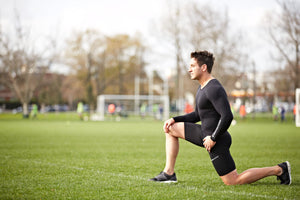"Recurrent hamstring muscle strain injuries are generally more severe and result in significantly more lost time in comparison to the initial injury."
About Hamstring Re-Injury
 There’s a lot of information around on how to prevent, treat, and rehabilitate hamstring injuries. Hamstring strain injury is one of the most common injuries in sports, and causes significant loss of training and competition time and significantly affects the quality of life of injured athletes (Liu, et al., 2012).
There’s a lot of information around on how to prevent, treat, and rehabilitate hamstring injuries. Hamstring strain injury is one of the most common injuries in sports, and causes significant loss of training and competition time and significantly affects the quality of life of injured athletes (Liu, et al., 2012).
What’s not often mentioned is that athletes that suffer from a hamstring injury experience a very high incidence of re-injury, even months or years after completing their recovery and rehabilitation. Recurrent hamstring muscle strain injuries are generally more severe and result in significantly more lost time in comparison to the initial injury. (Liu, et al., 2012)
| Sport | % Risk of hamstring injury recurrence |
| English Professional Soccer | 12-48% |
| Australian Football | 34% re-injury within one year |
Table 1: Percentage risk of hamstring injury recurrence in sport. (Liu, et al., 2012)
Why is Hamstring Re-Injury So Common?
 A recent study (Daly, et al., 2016) examined the biomechanics (the study of the action of external and internal forces on the living body) of athletes who had previously had a hamstring injury to determine whether they could pinpoint why there was such a high risk of re-injury.
A recent study (Daly, et al., 2016) examined the biomechanics (the study of the action of external and internal forces on the living body) of athletes who had previously had a hamstring injury to determine whether they could pinpoint why there was such a high risk of re-injury.
What they found was that even 11 months after the initial injury, athletes who had previously experienced a hamstring injury had weaker hamstrings, and that their pelvic and hip areas were no longer moving symmetrically as compared to non-injured athletes. Specifically, the previously injured athletes experienced an anterior hip tilt and a greater degree of knee rotation during exercise – the exact position that puts an athlete at a higher risk for hamstring injury. These changes were un-detectable to the naked eye but clearly captured by precision equipment used in their experiment. To add further insult to injury, these changes in rotation of the athlete’s knee is a mechanism closely associated with biomechanical risks of meniscal and anterior cruciate ligament injury.
The authors of the study hypothesized that the long term nature of this existing dysfunction could indicate an adaptive change in the biomechanics of the athlete. That is, that the athlete changed the way they moved their body in response to their hamstrings being weaker, and this has put them at further risk of re-injury, and has lessened muscle activation in the affected leg’s biceps femoris (hamstring) muscle.
Hamstring Re-Injury at a Glance
- Hamstring injury results in long term risk of re-injury
- Athletes with a prior hamstring injury still had hip and pelvic dysfunction 11 months after the initial injury
- This dysfunction increases the risk of re-injury
- Athletes with a prior hamstring injury experienced less muscle activation and corresponding weakness of the hamstring muscle while exercising 11 months after the initial injury.
- Prior hamstring injury could put the athlete at a higher risk for knee injury.
What Can You Do To Prevent Hamstring Re-Injury?
 Traditionally used methods to strengthen and protect the hamstring muscles are always going to benefit anyone looking to reduce and/or recover from injury. However, by understanding the way the body moves after recovery from a hamstring injury, we’re logically able to deduce from the results that athletes would benefit from:
Traditionally used methods to strengthen and protect the hamstring muscles are always going to benefit anyone looking to reduce and/or recover from injury. However, by understanding the way the body moves after recovery from a hamstring injury, we’re logically able to deduce from the results that athletes would benefit from:
- Additional activation of the biceps femoris (hamstring muscle) during training and competition.
- Additional support and strengthening of the pelvis, hip, and knee during training and competition.
These two things can be achieved in a number of ways. Here at Supacore, we’ve engineered these types of support and activation into compression that athletes are able to wear during training. The patented CORETECH injury recovery waistband supports the hip and groin areas (and in the full length tights – the knees), whilst encouraging activation of deep core muscles to further strengthen the body’s internal stabilisation system. Additionally, the RIBTECH technology built into the clothing across major muscle groups, including the hamstrings, creates controlled stimulation over those areas – a key factor in ensuring position specific muscle activation. Combined with the added benefits of graduated medical grade compression – this makes Supacore CORETECH products a “must-have” tool in your hamstring re-injury prevention toolkit**.
 |
|
** As with all injury and rehabilitation, the exact method/s used to treat and prevent injury should be discussed with your healthcare professional.
References
Daly, C. et al., 2016. The biomechanics of running in athletes with previous hamstring injury: A case-control study. Scandinavian Journal of Medicine and Science in Sport, 26(4), pp. 413-420.
Liu, H., Garrett, W. E., Moorman, C. T. & Yu, B., 2012. Injury rate, mechanism, and risk factors of hamstring strain injuries in sports: A review of the literature. Journal of health and sports science, 1(Unknown), pp. 92-101.


